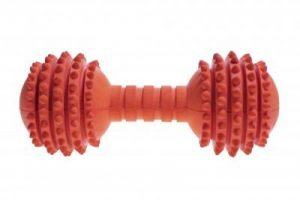Apr 18th 2016
Are Your Dog’s Toys Poisoning Him?
According to a presentation by the Society of Environmental Toxicology and Chemistry conference, many of the plastic and rubbery toys and fetching batons that our dogs chew on and play with every day, contain dangerous chemicals that may be harmful to their health.
Plastic and rubbery dog toys like this chew bone, may contain dangerous levels of poisonous chemicals.
You’ve no doubt read the warning labels or seen children’s toys and sippy cups advertising that they are now “BPA Free.” BPA, or bisphenol A, is a chemical added to plastic and vinyl to give it elasticity. Recent studies have shown that this chemical, which had previously been widely used in plastic and vinyl products ranging from cups and dinner plates, to toys and storage bins, acts as endocrine disruptors that mimic estrogen or act as anti-androgens when leached into the human body.
These recent studies and warnings regarding chemicals used in plastic and their danger to humans caught the attention of The Society of Environmental Toxicology and Chemistry, who decided to research the same chemicals and their potential danger in dog toys.
According to Discovery News, Phil Smith and Kimberly Wooten of Texas Tech University co-authored the study. Phil Smith, who raises, trains, and hunts with his Labrador Retrievers, was especially concerned with the fetching batons, or “bumpers,” that are commonly, and heavily, used during training, and plastic and rubber toys that many dogs play with every day, including chew-bones that are given to dogs as a supposed safe alternative to chewing real bones and foreign objects during teething.
To test for the chemicals, the researchers created simulated dog saliva, then simulated chewing by squeezing purchased bumpers and dog toys with stainless steel salad tongs. Some bumpers and toys were also weathered outside to determine if older toys gave off more chemicals.
“We found that the aging or weathering the toys increased concentrations of BPA and phthalates,” Smith explained. “The toys had lower concentrations of phthalates than the bumpers, so that’s good news. But they also had some other chemicals that mimicked estrogen. We need to find out what those are.”
Wooten explained that BPA and phthalates can have effects on developing fetuses and can have a lifelong effect on offspring of lab animals. Studies on humans have resulted in mixed conclusions, but concern was enough to warrant the U.S. government banning the use of BPA in baby bottles this year.
Many more studies have yet to be conducted, especially regarding the safety of these rubber and plastic toys and the chemicals that are leached into our dogs’ bodies. However, Smith and Wooten’s research indicated that levels of BPA and phthalates contained within dog toys are higher than those normally found in children’s toys.

